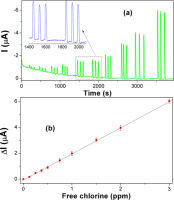P. Salazar, M. Martín, J.L. González-Mora, A.R. González-Elipe
Talanta 146, (2016) 410-416
doi: 10.1016/j.talanta.2015.08.072
The performance for free chlorine detection of surfactant-modified Prussian Blue screen printed carbon electrodes (SPCEs/PB-BZT) have been assessed by cyclic voltammetry and constant potential amperometry. The characterization of SPCEs/PB-BZT by X-ray photoemission, Raman and infrared spectroscopies confirmed the correct electrodeposition of the surfactant-modified PB film. These electrodes were incorporated in a Flow Injection device and the optimal working conditions determined as a function of experimental variables such as detection potential, electrolyte concentration or flow-rate. The sensor presented a linear response in the range 0–3 ppm free chlorine, with a sensitivity of 16.2 μA ppm−1 cm−2. The limit of detection (LOD) (S/N=3.3) and the limit of quantification (S/N=10) amounted to 8.25 and 24.6 ppb, respectively, adequate for controlling tap and drinking waters. To demonstrate the feasibility of using this free chlorine sensor for real applications possible interferences such as nitrate, nitrite and sulfate ions were successfully tested and discarded. Real free chlorine analysis was carried out in spiked tap water samples and commercial bleaches.


